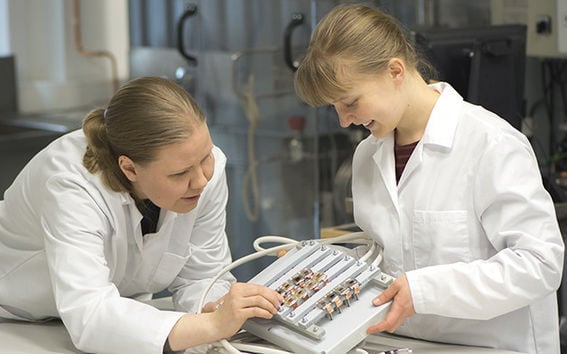Life-span of new solar cell technologies to increase even tenfold with methods developed in doctoral study

Armi Tiihonen defended her doctoral dissertation at Aalto University 6 April 2018 on the ageing of new kinds of perovskite and dye-sensitised solar cells. She has developed ways to increase the lifetime of solar cells and also proposes ways to improve ageing tests for them.
'Perovskite solar cells have not previously been studied using a fast, low-threshold photography method. With it, we could detect even the slightest disintegration in the perovskite. This could mean that in some instances, our photography method could replace a more thorough and laborious method called X-ray crystallography', says doctoral student Armi Tiihonen.
The photography method can help to determine when X-ray crystallography may be needed. If no changes can be detected in the photography, crystallography can be postponed. Photography also yielded more reliable results than optical measurement devices, for example.
The detection is based on changes in colour that aging often induces in the cells. The electrolytes in dye-sensitised cells contain iodine that is bright yellow and gradually turns transparent with age. Likewise, perovskite cells turn from a very dark colour into yellow as the perovskite disintegrates. Once these changes become measurable, the aging process can be analysed quantitatively.
The photographic method could be useful in industrial production of both perovskite and dye-sensitised solar cells because it is a fast and cost-effective way to detect changes brought on by aging.
Tiihonen’s research includes extensive analysis of ageing tests of perovskite and dye-sensitised solar cells, and serious shortcomings were observed in them. Furthermore, Tiihonen with her colleagues present ways to increase the life-span of the cells by reducing the bleaching in the electrolytes.
'Understanding the ageing mechanism is very important. By modifying the cell structure and the electrolyte we have managed to achieve as much as a tenfold increase in the lifetime of solar cells,’ emphasises Docent Kati Miettunen.
In comparing iodine and cobalt electrolytes, ageing was observed to slow down when the charge carrier was switched. It turned out that iodine electrolytes are not the more resilient one of the two, as had been assumed.
'We studied the effects of environmental factors on the bleaching of the electrolytes and the ageing of the cells. Reducing impurities, such as water, and filtering UV light were important, but the benefits gleaned from these proved less significant than we had anticipated,’ Tiihonen adds.
Dye-sensitized cells have extensive application possibilities, as they can be made out of many different combinations of materials and in many different colours. Perovskite cells, meanwhile, are very much in vogue because of their rapid development: their efficiency has increased nearly tenfold in a decade to about 20 per cent.
In addition to their research work, Armi Tiihonen, Kati Miettunen, Janne Halme and professor Peter Lund have actively proposed improvements to the research in their field. Most recently, they have issued a letter to Science magazine stating that with better-quality ageing tests it would be possible to extend the lifetime of perovskite and dye-sensitised solar cells.
Further information:
Armi Tiihonen
Doctoral Student
Aalto University
[email protected]
tel. +358 50 4683431
Kati Miettunen
Docent, Project Manager
Aalto University
[email protected]
tel. +358 50 3441729
Read more news

Get to know us: Associate Professor Maria Sammalkorpi
Sammalkorpi received her doctorate from Helsinki University of Technology 2004. After her defence, she has worked as a researcher at the Universities of Princeton, Yale and Aalto.
Aalto computer scientists in ICML 2024
Computer scientists in ICML 2024
In low-hierarchy organisations, even key policy issues are discussed in Slack
In a recent study, Aalto University alumn Lauri Pietinalho, a visiting scholar at New York University's Stern School of Business, and Frank Martela, an assistant professor at Aalto University, investigated how low-hierarchy organisations deal with shared policies in confrontational situations and how authority functions within them.